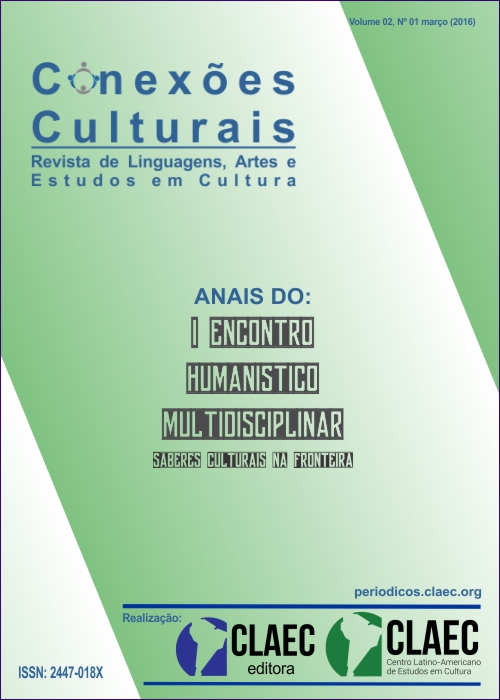Un Estudio de las Políticas Públicas para la Gestión del Patrimonio Cultural Inmaterial en Uruguay
DOI:
https://doi.org/10.23899/relacult.v2i1.26Palavras-chave:
Heritage, Intangible Heritage, Patrimonialization, Public policies.Resumo
El presente trabajo busca hacer una revisión de la evolución del patrimonio cultural inmaterial en Uruguay, para entender las dificultades y limitaciones que este patrimonio enfrenta en la actualidad. En un primer momento se presentará el rol que el Estado ha mantenido con este patrimonio inmaterial cuando aún la categoría no existía como tal y la Convención para la Salvaguarda del Patrimonio Inmaterial de UNESCO (2003) no había sido ratificada por Uruguay. Contando con estos antecedentes, se pasarán a analizar las actuales normativas y decretos que rigen el campo del patrimonio inmaterial para comprender cómo las diferentes expresiones inmateriales son concebidas y gestionadas. Desde el 2009, Uruguay cuenta con dos elementos declarados por la UNESCO como Patrimonio Inmaterial, el Tango y el Candombe. Esta segunda manifestación será el hilo conductor a través del cuál se verá cómo a lo largo de los años la expresión fue trabajada desde el Estado. A partir de entrevistas realizadas a las autoridades de diferentes instituciones de patrimonio inmaterial y un profundo estudio de textos académicos, el artículo busca entender el entramado y disputa entre el Candombe y sus intereses y la estructura del Estado y sus posibilidades para gestionar y salvaguardar este patrimonio.
Referências
ARANA, Mariano. Luces y sombras de nuestro patrimonio arquitectónico. (texto para aula inaugural ministrada em 2014).
BORTOLOTTO, Chiara “Il patrimônio immateriale secondo l’UNESCO: analisi e prospective”, Istituto poligráfico e Zecca dello Stato, Libreria Dello Stato, Roma, 2008.
BORTOLOTTO, Chiara, “le patrimoine culturel immatériel- enjeux d’une nouvelle catégorie”, Éditions de la Maison des sciences de l’homme, 2011.
CHAGAS, K. & STALLA, N. Salvaguarda del PCI afrodescendente en Uruguay. Informe CRESPIAL, 2011? pp. 1-94.
PASCUAL, Cecilia, Exposición de Cecilia Pascual, Licenciada en Ciencias Antropológicas, representante del Área de Patrimonio Inmaterial de la Comisión del Patrimonio Cultural de la Nación, Ministerio de Educación y Cultural, Uruguay.
QUINTELA, Alberto. La institucionalidad del patrimonio cultural en Uruguay. In: SOSA, Ana M. G.; FERREIRA, Maria Leticia M. & REY ASHFIELD, William. Patrimônio cultural: Brasil e Uruguai: os processos de patrimonialização e suas experiências. Pelotas: Ed. da Universidade Federal de Pelotas, 2013. - 243p.
ROMERO, Sonnia G.; et. all. Patrimonio Cultural Inmaterial del Uruguay – 2010. Montevideo: Comisión de Patrimonio Cultural de la Nación - Ministerio de Educación y Cultura. Texto em pdf.
RICOEUR, Paul. A Memória, a História e o Esquecimento. Campinas, Edunicamp, 2007
UNESCO, 2003, Convenção para a Salvaguarda do Patrimônio imaterial do 2003.
UNESCO, ”Políticas Transversales en Cultura, Turismo y Ambiente: desafios y oportunidades en Uruguay”, Montevideo, 2008.
UNESCO, Sector Cultura y patrimonio mundial, Ofician regional de ciencia para América Latina y el Caribe, “Legislación en el MERCOSUR relativas a las Convenciones de Cultura aprobadas por la UNESCO.”, Estudio de la situación actual en Argentina, Brasil, Paraguay y Uruguay, 2007.
Downloads
Publicado
Edição
Seção
Licença
Autores que publicam nesta revista concordam com os seguintes termos:
Os autores retêm os direitos autorais de suas obras e concedem à RELACult o direito de primeira publicação. Todos os artigos são simultaneamente licenciados sob Creative Commons Atribuição 4.0 Internacional (CC BY 4.0) (https://creativecommons.org/licenses/by/4.0/), permitindo o compartilhamento, distribuição, cópia, adaptação e uso comercial desde que atribuída a autoria original e indicada a primeira publicação nesta revista.
A RELACult disponibiliza todo o seu conteúdo em acesso aberto, ampliando a visibilidade e o impacto dos trabalhos publicados. As informações de contato fornecidas no sistema de submissão são utilizadas exclusivamente para comunicação editorial e não serão compartilhadas para outros fins.

